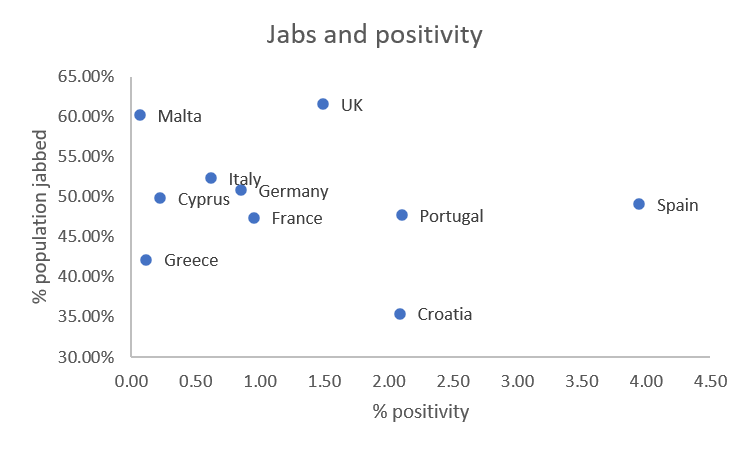1 July 2021
Lies, Damned Lies and Coronavirus
Summer holidays?
by David Chilvers
 Last week, the UK extended the number of countries on its green list for overseas travel, adding the Balearic Islands, Madeira, Malta and half a dozen Caribbean islands. Being on the green list removes the need for quarantine on return from any of the countries on the list. Hitherto, the green list had included Australia and New Zealand, Iceland, Israel and some islands in the South Atlantic. Apart from Iceland and Israel, none of the original green list countries were tourist hotspots and most had anyway refused to accept visitors from the UK.
Last week, the UK extended the number of countries on its green list for overseas travel, adding the Balearic Islands, Madeira, Malta and half a dozen Caribbean islands. Being on the green list removes the need for quarantine on return from any of the countries on the list. Hitherto, the green list had included Australia and New Zealand, Iceland, Israel and some islands in the South Atlantic. Apart from Iceland and Israel, none of the original green list countries were tourist hotspots and most had anyway refused to accept visitors from the UK.
So, does this extension of the green list presage a boom in holiday bookings to the new countries added to the list? Perhaps, but there are two constraints to this happening. Firstly, all the countries added, apart from Malta, are also on the green watchlist; this means their status can be changed from green to amber at very short notice, with amber requiring 10-day quarantine on return. Secondly, although you can get back from these countries without the need to quarantine, there may be restrictions imposed when you arrive there. Greece, Spain and Portugal allow travellers from the UK to enter without quarantine, whilst Italy, Germany and France have already announced quarantine rules for UK travellers no matter what their vaccination status. Poland will only allow fully vaccinated UK travellers in without a requirement to quarantine.
But the rules in Europe could get tighter as concerns grow over the possibility of British tourists spreading the Delta variant, which is now dominant in the UK. German Chancellor Angela Merkel has led calls for EU states to force all UK travellers to enter quarantine when they arrive, due to concerns about the more transmissible variant. The concern in Europe is that whilst high vaccination levels in the UK mean that increasing numbers of cases are not leading to serious illness, the lower vaccination levels in Europe leave vulnerable citizens in these countries open to infection and serious illness from UK holiday makers.
So, how justified is the reaction to consider banning UK residents from travelling to countries in Europe. On the face of it, the current level of cases in the UK, driven by the Delta variant, puts us out of line with trends in Europe.
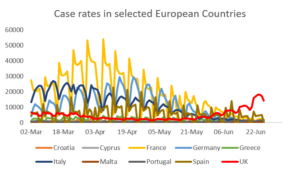
The number of UK cases, shown in red from the UK Coronavirus Dashboard , has steadily increased since late May, whilst the number of cases elsewhere in Europe remains very low, as measured by the European Centre for Disease Prevention and Control – ECDC. But as we have seen before, the number of cases is driven by the level of testing; if you double the number of tests, you will increase the number of cases identified.
For the 10 holiday destinations analysed above, the UK is undertaking a lot more tests per million population than all except Cyprus and Greece.
| Country | Current daily tests per million | % of UK |
| Croatia | 2,138 | 16% |
| Cyprus | 49,759 | 376% |
| France | 4,531 | 34% |
| Germany | 1,919 | 15% |
| Greece | 29,517 | 223% |
| Italy | 4,076 | 31% |
| Malta | 3,045 | 23% |
| Portugal | 4,501 | 34% |
| Spain | 2,304 | 17% |
| UK | 13,230 | 100% |
Cyprus is testing about 5% of its population every day, Greece about 3% but testing levels in all the other countries are between one sixth and one third of that in the UK. So given our level of testing, it’s not surprising that the number of cases is high.
A better metric to look at is case positivity – the number of cases divided by the number of tests – expressed as a percentage. This data is also available on the ECDC website and the figures for the same 10 countries are shown below.
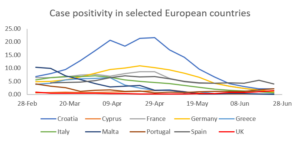
This shows a different picture. Although the % positivity in the UK is increasing, it is still below that for several other countries, notably Portugal and Spain. The table below shows the positivity rate for the latest week shown on the ECDC site (w/e 24 June apart from Croatia which is for the preceding week).
| Country | Test positivity % | % of UK |
| Croatia* | 2.09 | 140% |
| Cyprus | 0.22 | 15% |
| France | 0.95 | 64% |
| Germany | 0.85 | 57% |
| Greece | 0.12 | 8% |
| Italy | 0.62 | 41% |
| Malta | 0.07 | 4% |
| Portugal | 2.10 | 141% |
| Spain | 3.95 | 265% |
| UK | 1.49 | 100% |
The positivity rate is very low for Malta, Greece and Cyprus and between 41% and 64% of the UK rate for France, Germany and Italy. So, although the positivity rate for the UK is rising, it is only a little above that for France, Italy and Germany and less than that for Croatia, Portugal and Spain. The factor that is pushing up the number of cases in the UK is the much higher level of testing than in all of the large European countries. Moreover, much of the UK testing effort is focussed on surge testing, in areas with high prevalence of cases and among children, where the virus is spreading quite quickly. If you focus testing on areas of high prevalence, the positivity rate will be higher than in a random sample; in the ONS (random) survey for the week ending 19th June, the positivity rate was 0.22%, substantially below the 1.49% figure above for those testing both with symptoms and asymptotically.
The other factor influencing opinion in European countries is the progress of the vaccination programme. In terms of at least one dose, the UK and Malta are well ahead of the other eight selected countries.
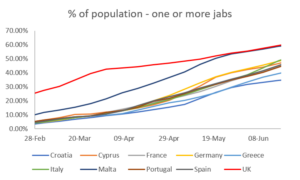
A similar pattern exists for second jabs, with Malta and UK even further ahead of the other eight selected countries.
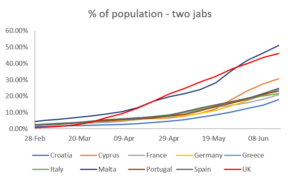
By putting current (at least one dose) vaccination data with current positivity rates gives an interesting pattern:

In a chart like this, you want to be in the top left-hand quadrant – high vaccination rates and low positivity rates – Malta is here. You really don’t want to be in the bottom right-hand quadrant – low vaccination rates and high positivity – Croatia is here. The other eight countries have similar vaccination rates, with low positivity for Greece and Cyprus and high positivity for Spain.
To summarise, the relatively high number of cases in the UK at the moment is largely driven by the greater level of testing – once this is taken into account, the differential between the UK and other large European countries such as France, Germany, Italy and Spain is substantially diminished. What I think is really creating concern in Europe is their low level of vaccination, including among vulnerable groups. Domestically in the UK, the vaccination programme seems to have largely broken the link between infection and serious illness; but in Europe the lower level of vaccinations creates a risk that UK holiday makers will pass infection on to local populations, who are not as protected as the UK population due to slower vaccine rollout. When European governments want to limit visitors from the UK, they are really admitting that their vaccination programme is not sufficiently advanced as to provide the protection that is apparent domestically here. The high UK case numbers are a bit of a red herring, as the level and focus of testing explains a lot of the difference with other large European countries.
This article is one of a series, the previous article on it seems like yesterday is here.

